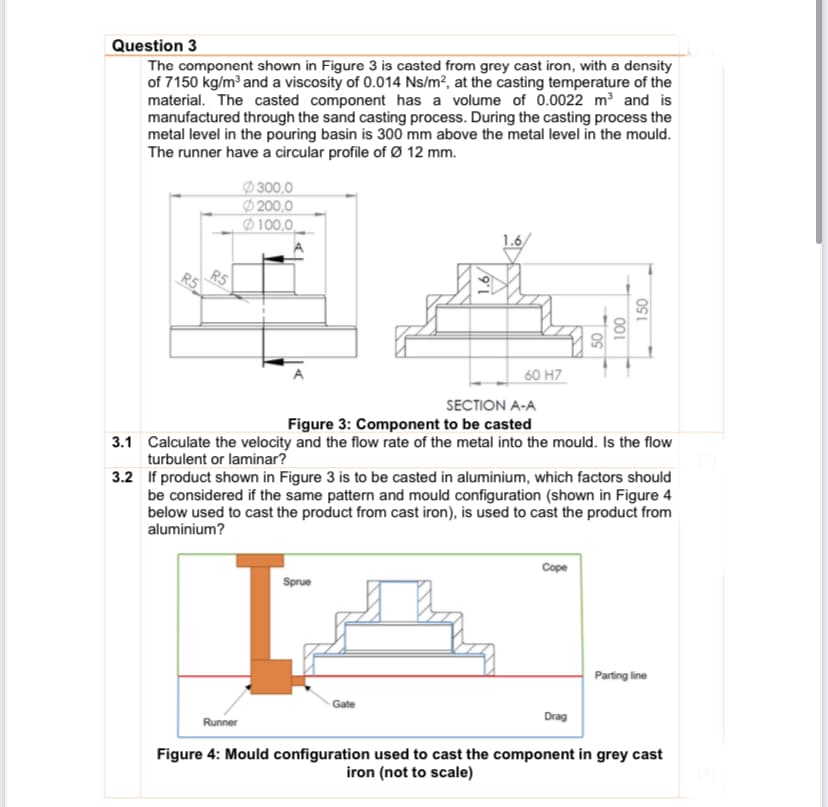density grey cast iro component of 7150 kg/m and a viscosity of 0.014 Ns/m², at the casting temperature of the material. The casted component has a volume of 0.0022 m³ and is manufactured through the sand casting process. During the casting process the metal level in the pouring basin is 300 mm above the metal level in the mould. The runner have a circular profile of Ø 12 mm. Figure Ø 300,0 Ø 200,0 Ø100,0 1.6 RS R5 001
density grey cast iro component of 7150 kg/m and a viscosity of 0.014 Ns/m², at the casting temperature of the material. The casted component has a volume of 0.0022 m³ and is manufactured through the sand casting process. During the casting process the metal level in the pouring basin is 300 mm above the metal level in the mould. The runner have a circular profile of Ø 12 mm. Figure Ø 300,0 Ø 200,0 Ø100,0 1.6 RS R5 001
Elements Of Electromagnetics
7th Edition
ISBN:9780190698614
Author:Sadiku, Matthew N. O.
Publisher:Sadiku, Matthew N. O.
ChapterMA: Math Assessment
Section: Chapter Questions
Problem 1.1MA
Related questions
Question

Transcribed Image Text:Question 3
The component shown in Figure 3 is casted from grey cast iron, with a density
of 7150 kg/m and a viscosity of 0.014 Ns/m², at the casting temperature of the
material. The casted component has a volume of 0.0022 m3 and is
manufactured through the sand casting process. During the casting process the
metal level in the pouring basin is 300 mm above the metal level in the mould.
The runner have a circular profile of Ø 12 mm.
Ø 300,0
Ø 200,0
Ø100,0.
1.6/
R5
R5
60 H7
SECTION A-A
Figure 3: Component to be casted
3.1 Calculate the velocity and the flow rate of the metal into the mould. Is the flow
turbulent or laminar?
3.2 If product shown in Figure 3 is to be casted in aluminium, which factors should
be considered if the same pattern and mould configuration (shown in Figure 4
below used to cast the product from cast iron), is used to cast the product from
aluminium?
Cope
Sprue
Parting line
Gate
Drag
Runner
Figure 4: Mould configuration used to cast the component in grey cast
iron (not to scale)
001
Expert Solution
This question has been solved!
Explore an expertly crafted, step-by-step solution for a thorough understanding of key concepts.
This is a popular solution!
Trending now
This is a popular solution!
Step by step
Solved in 2 steps with 1 images

Knowledge Booster
Learn more about
Need a deep-dive on the concept behind this application? Look no further. Learn more about this topic, mechanical-engineering and related others by exploring similar questions and additional content below.Recommended textbooks for you

Elements Of Electromagnetics
Mechanical Engineering
ISBN:
9780190698614
Author:
Sadiku, Matthew N. O.
Publisher:
Oxford University Press

Mechanics of Materials (10th Edition)
Mechanical Engineering
ISBN:
9780134319650
Author:
Russell C. Hibbeler
Publisher:
PEARSON

Thermodynamics: An Engineering Approach
Mechanical Engineering
ISBN:
9781259822674
Author:
Yunus A. Cengel Dr., Michael A. Boles
Publisher:
McGraw-Hill Education

Elements Of Electromagnetics
Mechanical Engineering
ISBN:
9780190698614
Author:
Sadiku, Matthew N. O.
Publisher:
Oxford University Press

Mechanics of Materials (10th Edition)
Mechanical Engineering
ISBN:
9780134319650
Author:
Russell C. Hibbeler
Publisher:
PEARSON

Thermodynamics: An Engineering Approach
Mechanical Engineering
ISBN:
9781259822674
Author:
Yunus A. Cengel Dr., Michael A. Boles
Publisher:
McGraw-Hill Education

Control Systems Engineering
Mechanical Engineering
ISBN:
9781118170519
Author:
Norman S. Nise
Publisher:
WILEY

Mechanics of Materials (MindTap Course List)
Mechanical Engineering
ISBN:
9781337093347
Author:
Barry J. Goodno, James M. Gere
Publisher:
Cengage Learning

Engineering Mechanics: Statics
Mechanical Engineering
ISBN:
9781118807330
Author:
James L. Meriam, L. G. Kraige, J. N. Bolton
Publisher:
WILEY